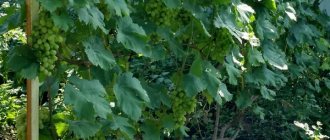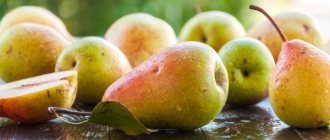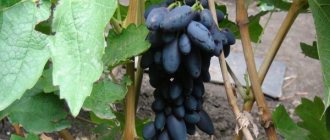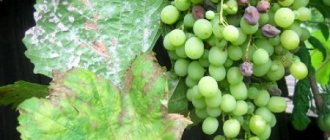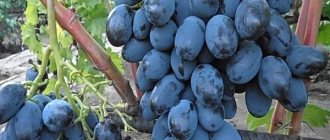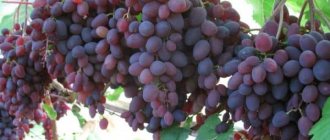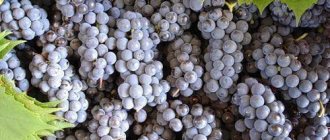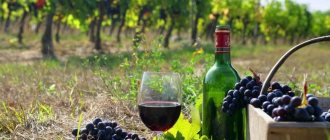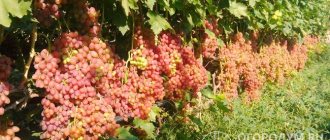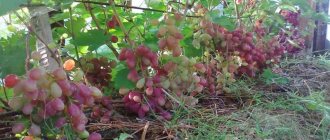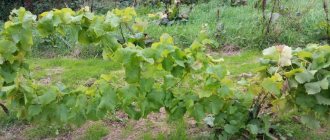Lovers of fresh grapes are happy to grow sweet and juicy Krasen grapes in their dachas or buy them at markets. This variety is universal in its own way. It is suitable for both wine production and juice production. And the popularity of fresh grapes of this variety is supported not only by their visual attractiveness and increased sugar content, but also by the absence of seeds.
History of the variety
To develop the variety, the generative hybridization method was used. This is one of the main methods of selection, based on pollination of generative organs. With this method, the male flowers are removed from the mother bisexual grape and then pollinated by the father variety. If only the female type of flower is present on the grape, then pollination is simply carried out by the paternal form. The main difficulty of this method is the correct selection of varieties for crossing.
Scientists from the Magarach Research Institute, which studies the problems of viticulture and winemaking, worked to obtain this hybrid form. The institute is located in the city of Yalta. To obtain the Krasen grape variety, we used the disease-resistant, very early seedless Magarach and the frost-resistant Antey Magarach variety. The result of the selection work pleased the creators. The hybrid form turned out to be universal, suitable for industrial cultivation and for small farms, stable and undemanding. Such varieties are classified as table-technical varieties.
NIViV "Magarach" received a patent for the developed variety, the number of which is 06285. After this, industrial vineyards were planted for technical purposes, and the promotion of the variety for home cultivation began.
Appearance
Krasen grapes have large, medium-loose clusters containing relatively small berries. On average, the weight of a bunch is just over 600 g, but there are giants weighing more than 1 kg. The clusters have a pointed conical shape.
Krasen's berries are round, slightly elongated, blue-violet in color. A waxy coating is visible on the surface. The pulp of the berries is juicy and fleshy. It has a light nightshade and nutmeg flavor. The skin is strong but thin. The juice is rich in color. The pulp contains rudiments of seeds. Their size does not exceed 2 mm. To the touch, the rudiments are slightly denser than the pulp itself. In fact, they are not taken into account and the Krasen grape variety is classified as raisins.
Growing rules
Growing this grape variety has its own rules and characteristics. The culture loves compact planting. To achieve a high yield, each vine is planted at a distance of 50 cm from each other. Before planting, it is necessary to carefully examine the seedling. It should not have any mechanical damage, scratches, wounds, rot or mold. It should not be over-moistened or over-dried. The seedling must have a powerful stem and a well-developed root system.
Before planting a plant, you should pay attention to the following nuances: the place where the crop will grow must be sunny. The grapes will not develop well in the shade;
- there must be groundwater nearby;
- There should be no fruit trees or shrubs growing nearby so that the grapes receive quality nutrition.
Description of the variety
Despite the fact that the parent forms of Krasenya were early, the variety itself belongs to the average ripening period. Grapes need 135-145 days to reach ripeness. These terms depend on the method of application of the crop and the climatic zone of cultivation. The Krasen grapes, described in this section, ripen in the southern regions by mid-August. In more northern regions - by September. For winemaking, Krasen is kept on the bushes until the second half of September. And for table use, grapes can be harvested earlier.
Krasen is a vigorous hybrid variety. It stands out for its almost 100% bud fertility. In this case, the bud can bear fruit, even if it is frozen during frost. Krasen grapes are, in principle, a high-yielding variety. With industrial cultivation, the yield is up to 180 centners per hectare. The peculiarity of the variety is the ability of the bush to withstand high loads without compromising the appearance and quality of the berries. The ripening period also does not change. Each vine can support two large clusters or three medium ones.
Considering the Krasen grapes, the description of the variety should be continued with frost resistance indicators. The bush is able to survive winter with frosts down to -26° C. In the southern regions it is not covered for the winter, in colder climates - at the request of the gardener. But if the winter promises to be frosty, then it is better to cover it.
The variety feels great in Crimea, in the Krasnodar region. The climate of these regions is optimal for a good harvest. The variety is suitable for cultivation in the Cherkasy and Kyiv regions of Ukraine, Rostov and Voronezh regions of Russia. Good frost resistance allows you to obtain harvests even in the northern regions. Krasen showed himself with dignity in Tyumen, Omsk, near Novosibirsk and Barnaul.
Planting seedlings
Planting is done in the spring, since grapes are a heat-loving plant. The pit has been prepared since autumn. Its depth depends on the length of the roots of the seedlings. A drainage layer is constructed at the bottom. Then a layer of fertile soil mixed with organic matter and complex mineral fertilizers is poured.
Review of the Osennyaya Yakovleva pear variety: advantages, disadvantages, nuances of cultivation
The seedlings are sprinkled with earth and watered abundantly. To improve rooting, a few hours before planting, you need to place the seedlings in a solution that stimulates root growth.
Agrotechnical features
When growing Krasen grapes, the gardener can influence the weight and size of the bunches by shaping the bush. Compact design increases yield.
Krasen is characterized by polarity of growth. This means that the upper buds are growing rapidly, so it is worth planting bushes in personal plots near arbors or stable trellises. The polarity of growth can be changed by moving the ends of strong vines to lower levels.
Proper watering
According to the rules, the first watering of these grapes is carried out after removing the winter shelter (if the grapes are grown in cold areas). Before this, the vines are tied to the bottom bar of the trellis or arbor. Up to three years, the bushes are watered at the root. This means that a piece of pipe is dug in near the bush, and several buckets (3-4) of cold water are poured into it. 0.5 liters of wood ash are poured into the water. The second watering is performed before flowering. The third one should be done during fruit formation. Watering is not carried out from the moment the berries appear in color, but is resumed before wintering. The last watering is called moisture recharging or winter watering.
Mature bushes do not need as much watering. After three years, Krasen grapes are watered once, before entering the wintering area.
Top dressing
When planting Krasenya, fertilizers are applied into the hole, which is enough for three years of full development and formation of the bush. Then the fruiting period begins, so the vine requires additional nutrients. The variety can be fed with organic fertilizers (manure, bird droppings, compost, peat). Mineral fertilizing is carried out with ammonium nitrate, urea (nitrogen fertilizers), superphosphates (phosphorus fertilizers), potassium salt, potassium chloride and sulfate (potassium fertilizing).
The introduction of micronutrients is carried out in three stages:
- At the end of winter. During this period, 40 g of superphosphate, 30 g of potassium and 45 g of nitrate are added to the soil under each bush. The fertilizer is sprinkled with a layer of soil on top.
- Before flowering begins. During this period, diluted organic fertilizers are added to the soil. To do this, two weeks before application, manure or droppings are diluted with water and left under a tight lid. Before adding, the slurry is diluted again with water in a ratio of 1 to 6 and potassium (15 g) and superphosphate (25 g) are added to each bucket.
- Before the berries begin to ripen, superphosphate (50 g) and potassium (20 g) fertilizers are applied to each bush.
From July, feeding is stopped. Otherwise, the ripening of the crop can be slowed down. And if you overfeed Krasen, fruiting may not begin at all.
Caring for Krasen grapes
After planting, the seedling must be watered abundantly several times. If the weather is rainy, you may not need to water the plants. If the seedling was planted too early and the likelihood of frost is high, then you need to stop watering it to stop the appearance of ovaries.
Watering and fertilizing
Under one bush you need to add 1-2 buckets of water during hot weather. In total, seedlings are watered 2-3 times during the season. For the first time, the bushes will only need the fertilizers that were applied to the holes before planting.
When the bushes begin to bloom, they can be fed with mineral fertilizers and organic matter. To prevent the grapes from getting used to nutritious fertilizers, it is recommended to alternate the compositions. Potassium can be added during fruit ripening.
Formation of a fruiting vine
Clusters of grapes begin to form in June, but the berries are edible only from mid-August. As a rule, the Krasen variety fully ripens at the end of summer, and in the north - in mid-September. Cone-shaped clusters with round grapes are formed evenly on the vine.
Loosening and mulching the soil
In the spring, to preserve moisture in the soil and reduce the number of weeds, it is customary to mulch the soil around the bushes. During the summer season, the soil around the bush needs to be loosened to a depth of 10-15 centimeters as weeds appear and a crust of earth forms on the surface.
Preventative treatments
Each phase of bush development requires treatment, since diseases and pests may differ at different times of the year. Therapeutic fertilizing and spraying is done when the buds swell, at the moment of leaf formation and when berries form from the inflorescences. The next treatment can be done in mid-summer. The last prevention is carried out after harvesting.
Preparing the vine for winter
In the south, you don’t have to cover the bushes for the winter if the winter is warm. In the north, it is recommended to cover the vine before frost. For this, straw mats and advisory material are used. You can also use oilcloth.
Winemaking and other uses
Since 2008, these grapes have been included in the register of varieties for industrial cultivation. Due to its high sugar accumulation (30 g/100 cm³), the variety is used for the production of table and dessert wine. The Magarach trademark promotes the production of Cahors from Krasen grapes. The variety allows you to obtain a high percentage of wort yield (up to 78), which has a rich, deep color.
Juice can be obtained from Krasenya both at home and on an industrial scale. In households, their berries are used to make compotes and jam.
Many gardeners who grow the Krasen grape variety leave positive reviews. Excellent drinks are prepared from its fruits that will appeal to gourmet gourmets.
Reviews from gardeners
Most winegrowers and lovers of growing good grape varieties give positive reviews about Krasen.
Many people prepare delicious drinks that are distinguished by the exquisite taste of nutmeg with a berry flavor. When fresh, the richness of flavor is a very good factor, so for food it will be the best dessert on the table.
Gardeners in reviews note that this variety is grown with the least amount of chemicals and fungicides. This is one of the main qualities for quality grape care. But they also note that it is quite resistant to various diseases, so there is no need to take special protective measures.
